The Portland Tribune reports that U.S. Congressman Peter DeFazio has spoken out against current plans for the Columbia River Crossing (CRC) project.
Echoing a popular sentiment around the project these days, DeFazio — who chairs the all-important House Transportation and Infrastructure Committee — told the Tribune that “What has been designed so far is sort of the optimal project, and we can’t afford that.”
What’s been “designed so far” is a 12-lane, $4.2 billion project that includes not just a new bridge over the river but several very expensive new interchanges on both sides.
On the topic of those interchanges, DeFazio also told the Tribune that a priority should be put on “throughput” traffic — meaning the actual crossing of the river as opposed to building/improving interchanges leading up to the river.
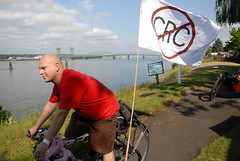
no to the CRC is much more
politically acceptable these days.
DeFazio also said that the project must have light-rail and tolls to be feasible. Sound familiar? That’s because Portland Mayor Sam Adams said essentially the same thing in his news-making announcement about the project last month.
With DeFazio’s remarks, the CRC project as it’s currently planned, will almost certainly face major changes in the coming months. There is talk of going back to the drawing board and figuring out how to budget about half of the currently proposed funds.
Metro Councilor Rex Burkholder shared recently that talks are already underway as to how best to trim just over $2 billion off the current price tag. Most likely, as DeFazio alluded to in his comments, most of the budget will be cut by doing away with planned interchanges (now let’s watch how Oregon and Washington fight over which side gives up on theirs).
As support erodes for the current CRC project, there’s an opportunity for someone (or some organization) to pick up the pieces and lead a new discussion for how best to cross the river in the future. Who will it be? As Mayor Adams said recently, “the ground has recently shifted” on this project. Now it’s a matter of who’s left standing and in what position.
(DeFazio CRC comments first seen on Portland Mercury blog.)


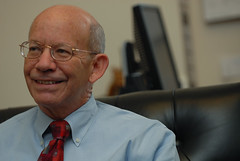
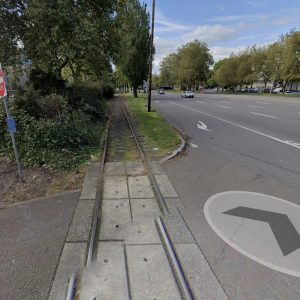
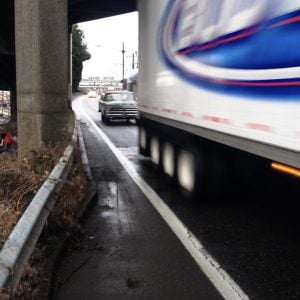
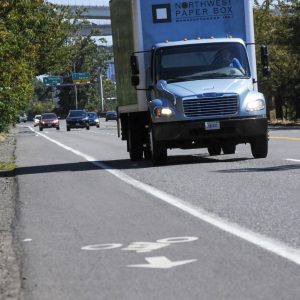
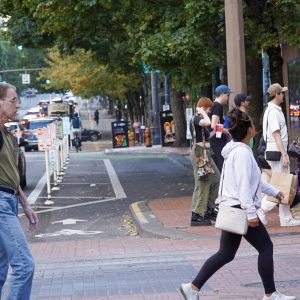
Thanks for reading.
BikePortland has served this community with independent community journalism since 2005. We rely on subscriptions from readers like you to survive. Your financial support is vital in keeping this valuable resource alive and well.
Please subscribe today to strengthen and expand our work.
woohooo!
Just a commentary not a persuasion:
We could save a lot of money by only building the light rail and bike crossing and that would improve commuting and reduce traffic, right? Let’s not spend any more money on cars! They got their bailout, their road resurfacing, their cash for clunkers, let’s spend a little money on good alternatives, and a new Sellwood bridge!
I hope someone takes care of this, it’s a project big enough to keep it running.
While I’m happy to see that another policy-maker is against the CRC as is, I’m not happy about his reasons. He simply wants to up throughput (i.e., more traffic) at the cheapest short-term price (and greater long-term cost).
I agree with Chris, improve ways of getting across. Reducing the number of single-occupancy cagers on the bridge would be a better long-term solution.
I wouldn’t call it ‘optimal’, I’d call it bloated beyond all necessity
Fix downstream rail bridge so that the cargo ships concerns are met.
Since it won’t have to meet any prohibitively expensive goals and won’t be driven on it should be subject to much less public debate.
Aside from the bridge lifts exacerbating SOV commutes how is the current bridge causing Portland and Oregon to suffer?
Is there any reliable research to back up claims of economic losses caused by our current bridge?
Portland is the biggest pinch point on the entire I-5 corridor.
The economic impact is felt up and down the west coast through increased costs of transportation of goods.
Not that increasing throughput or removing the need to raise the bridge is going to fix the problems with the Terwilliger hill/curves or the choke point on 205 at West Linn, or the 84/5 interchange.
Getting goods through Portland by truck stinks.
is that meant to say “short of optimal” ? Optimal means favorable.
Granted, this wouldn’t be the article to change.
Great news! Keep fighting to defeat this 1970s era five billion dollar “improvement”.
i’m seconding q’Tzal’s comment.
we know it’s a “pinch point” and “the economic impact is felt up and down the west coast through increased costs of transportation of goods”. i’m not denying that this is the case, it’s not a stretch to figure that big trucks get stuck in traffic thanks to clark county commuters. but some data would be preferred over anecdotes and the constantly repeated talking points.
Jonathan,
Is that your reporting for Burkholder’s quote about reducing the bridge cost by $2 billion?
I was always hopeful for some sort of “grand compromise” of reducing the size and scale of this project. Looks like we may have an opportunity here.
The freight argument has consistently been overstated in this ongoing conversation. The throughput DeFazio references is 8% of total traffic volume. The source of the 8% is the CRC itself.
Moreover, “fixing” the bottleneck with 12 lanes simply relocates that bottleneck to the Rose Quarter at Broadway, where I-5 returns to two lanes in each direction. Try to wrap your head around the financial and political cost of widening the freeway in Inner NE Portland. In recently completed or active projects alone you have the Left Bank Project, the new affordable housing/recovery center just north of the Rose Garden, and the eastside streetcar. Then in the near-term (compared to freeway widening in Inner NE) you have the potential for significant investment in the Rose Quarter itself.
There’s no way the freeway will be widened at that location. So all Portlanders gain from the 12-lane CRC is a shift of the bottleneck into the heart of their city.
And as Anonymous notes, the Terwilliger Curves are as much a problem as anything on the system and there’s no way they’re going away.
What you see is what you get on I-5 in Portland city limits. “Fixing” the Columbia span with the CRC only moves the problem into the heart of Portland.
It should be noted there are creative, if politically innovative, solutions to the freight issue. Like a limited hour freight-only lane. Or a toll structure that is free or reduced for freight and more for SOVs.
Despite spending $1 million per month the CRC staff has failed to meaningfully analyze innovative ways to get more value out of the existing infrastructure. That’s because this is a DOT-driven project with vigorous support of the unions who don’t care about good policy, only the chance to collect a paycheck.
“Getting goods through Portland by truck stinks.”
Then perhaps it’s time to improve the freight throughput of alternative modes. I’d like to see more consideration given to improving heavy rail connections.
Anyone who believes that Portland is the worst pinch point along the entire I-5 corridor has not driven the entire length of the I-5 corridor. This argument is a red herring. It is a pinch point. I driven the entire thing from Mexico to Canada multiple times. L.A. is a problem. Seattle is a problem. The Canadian and Mexican borders are a problem. Sacramento is a problem. Stockton is a Problem. Siskiyou pass can be a problem. The Grapevine can be a huge problem (particularly since Freight has to use a bypass route).
Some cities have altogether removed freeways. You can’t drive U.S. 101 through San Francisco anymore without doing surface streets. There is not a freeway that completely traverses San Francisco except I-280/80 where it only outskirts the southern edge of that city.
Don’t let anyone use the argument that freight is suffering on the Colombia crossing. Get rid of SOVs (add a toll) and freight will have all the space it needs.
Comments #, 2, 8, 14, 16 and 17 read together, express somewhat, my own outlook about what a new bridge over the Columbia might best be.
The metro area should stop enabling greater numbers of SOV’s to cross the river between states, day in and day out. If people want to do that kind of home to work commute, let them do so on the present bridges. When they get tired of the daily congestion cooped up in their cars, let them decide to ride mass transit, ride a bike or go by foot on a new bridge designed specifically for that purpose.
Answering west coast freight movement needs with an efficient heavy rail system designed specifically for that purpose sounds like a great idea.
Whether and how growth would be affected by building a big bridge favoring SOV traffic depends upon what form it’s decided that growth should take. I believe a lot of people are still very much interested in a future of housing growth… ‘…spreading out so far and wide…’ (to borrow from that crusty Green Acres ditty). I think there’s a better kind of growth than that.
Well said John, Post #4 and others.
Hardly a fit for “Put The Food Down”
More like dip a pinky in the water.
Real leadership would say NO to any plan that adds any extra lanes. No even if we had lots of money, and the bridge was a free gift from the French.
Real leadership would admit our many problems, and that single passenger commuters HOG the road in their single occupancy vehicle SOV. The HOGS block freight, the hogs will fill up the extra six lanes we add.
Buses, Trucks, Rail and Light rail should all be given priority and perhaps their own cost effective bridge, adding bikes to that would be very cheap.
My wife is happy biking the current bridge 3 times a week, and while I don’t speak for her, she says the bridge is not a pinch point, and bike money should be spent improving the paths leading to/from the bridge.
Put the freight and the commuters on trains already!
The trucking industry has already cost Oregon hundreds of millions of dollars. Remember the cracked bridges? The trucking lobbies persuaded Oregon politicians to increase bridge weight limits so they could haul heavier loads and they broke hundreds of bridges througout the state. They got their subsidy when Oregon taxpayers bought them (and continues to buy them) new bridges. They can just hush.
@16: Then perhaps it’s time to improve the freight throughput of alternative modes. I’d like to see more consideration given to improving heavy rail connections.
The ODOT and WSDOT high speed passenger rail proposals will have dramatic, positive impacts on freight rail as well. I don’t know why they don’t publicize that more.
Thanks for the update – as I am out of the loop traveling.
Well it looks like Mayor Pollard is the last currently elected supporter of the full package.
How about a fair deal – each state closes an exit on I-5? (WA closes the Sixth Street ramps/ relocates SR14 on ramp to the old sixth ramp; OR closes the Hayden Is ramps/ makes them arterial connections south) – messy but politically expediant?
Perhaps for the existing CRC project to survive it might need a grand compromise: mitigation the south bound bottle necks in Portland?
It’s mamusing to see how most of you approch this problem. Not from understanding the real issues. But from denying them and creating solutions which ignore reality.
You can hate SOV’s all you want. That isn’t going to make them go away. Free bicycles, free mass transit rides into Portland isn’t going to alter the equation by an appreciable amount. But to deny infrastructure upgrades based on irrational argument only prolongs an increasing problem.
No one seems the least bit concerned with money spent on Hiway 217 and 26 improvements. Yet you could argue that the money spent there just encourages more “cagers” to use those roads.
To deny improving throughput on the I-5 bridge due to additional pressure it will put on the Rose Garden Impasse is absurd. To be progressive and enlightened and resolve a 40 year old problem would make more sense. You essentially have a single lane of southbound travel there during peak hours.
The CRC project to be understood correctly requires awareness that a replacement bridge is only a component. The project itself ties in a number of interchanges on and off the island and to a number of connecting roads to the new bridge.
Sam Adams insistence on a flamboyant rather than utilitarian bridge design has not helped in the least. Dust off the plans for the existing I-205 bridge, add a section for a future light rail path and build a working bridge.
Don’t need, nor can we afford an iconic bridge built to honor any mayors. Don’t need to build light rail if people insist they are are not going to use it. Maybe in the future.
And begin plans on fixing the Rose Garden problem. Don’t tell me ODOT can’t do that. WSDOT just opened a parallel span over the Tacoma Narrows and is now replacing a floating bridge across Lake Washington in Seattle.
Either lead, follow, or get out of the way.
Bob-
I think that what you are saying id that we should just increase the ability of people to drive their cars around, and wit for them to get enlightebed enough to use public transit.
In reality it works the other way around- you allow congestion to induce demand for the transit and then offer the alternative.
Why should we do that you ask? Because those of us who live in the areas affected by the choices of others are tired of bearing the externalized cost. If people want to live in Clark County and work in Portland, let them sit in traffic in far N Portlands industrial areas or in Vancouver- instead of turning them into ratrunners through the city streets where many of us live.
The reality is that people need to carry the weight of their own choices. The Clark county new-bridge-no-toll only illustrates the selfishness of the car commuting mindset.
BURR #20
Put the freight and the commuters on trains already!
+1
The main disadvantage to a simple fix to the rail bridge is a lack of support for future high speed rail. I don’t know the specifications for the euro style high speed rail system that California is determined to install but I’m willing to bet that nothing short of a full replacement of the current rail bridge would be capable of being used by real high speed rail if at all.
Probably better off just fixing the current rail bridge and expecting that any future high speed rail bridge will be of an engineering specification that we can’t anticipate yet.
Best thing may be to build a sensible CRC but only with:
> light rail to Vancouver and a commitment to encouraging use of public transit.
> the same type of reserved transit ROW that the I-205 had for future high speed rail
> tolls to mitigate costs and traffic loading.
) while I agree that tolling should be used to shape the traffic load we should not encourage the inefficient moving of cargo by truck over more efficient trains.
Duncan #25 – What does philosophy and other religious garbage have to do with transportation planning? When you say that a million people should consider your own personal feelings before making any decisions of their own, how is it that you exclude yourself from this process? I’ll bet you moved here from somewhere else, where was this attitude then?
Cars across the river is bad because it causes sprawl, right? But I’ve seen you talk a lot about riding a bike across that bridge. So, sprawl is fine, as long as you ride a bike then?
Mass-transit is not viable. Never has been, never will be. A century of history proves me right, what have you got? It’s a health-risk above all, and horribly inefficient. It’s just a place for do-gooder busy-bodies to shuffle the poor people off to, and I’m tired people like you characterizing this any other way.
Increasing the cost of transportation will increase the price index. Decreasing transportation costs lowers the price index. There, and you don’t even need to know who Socrates was.
Bob #24
I absolutely agree that any bridge we build should be built for Function not Form. To allow beauty to dictate the price point is not ethical; it takes away funding from other projects to provide features that do not contribute a bridge’s actual purpose: to allow users to go from one side of the river to the other.
I say users because there seems to be a perception in Vancouver that the CRC is for motor vehicles only. Users includes cyclists, pedestrians and transit, both buses and light rail. The trucking traffic can go around on I-205(that’s ~36 miles vs ~27). Even with the extra 9 miles it’s worth it, from a trucker’s stand point, to avoid the downtown congestion, Terwilliger congestion and the tightly spaced downtown exits that make four-wheelers drive unsafely around heavy trucks.
So, the I-5 bridge doesn’t need to be there for anything more than local traffic. If it collapsed tomorrow truck traffic would all route to I-205. The community of Vancouver either stands on it’s own or it needs the jobs provided by Portland. If they want to be part of Portland’s economic community then they can learn to play by our rules.
Anon #8 says “Portland is the biggest pinch point on the entire I-5 corridor.”
If you repeat something enough some people believe it. But it’s simply not true.
Further, the I-205 was built to solve the pinch point. If it failed, then the question should be why did building more lanes not solve the problem. Induced demand, perhaps? Will we have the same problem down the line if we build the CRC as planned? Probably.
The real solution to the trucking issue is to reduced the amount single occupancy commuters during rush hour. That is the cheaper, easier, greener, more effective solution.
Now it is time to scrap this project and fire the CRC commission.
Dear Bob (#24),
Please tell me how putting a floating bridge over the Rose Quarter would help I-5? The idea itself is very “mamusing.” ODOT is good for sure, but they can’t be THAT ingenious!
Charley
#25
Nice to hear a differing view point.
> Public transit (per passenger/mile) will always cost than the gas for driving a car.
> Public transit (per passenger/mile) will always cost than the gas+insurance for driving a car.
> Public transit (per passenger/mile) will always cost than the gas+insurance+ownership+licensing+fees for use for driving a car.
This why we drive cars. It seems cheaper
All the costs of a public transit system are front and center for taxpayers to see.
All the costs of the Public Asphalt system are hidden elsewhere.
All the costs of the subsidies for oil and gasoline production are hidden elsewhere.
As long as we continue to allow our governments to play the same monetary shell games that the Securities and Exchange Commission made illegal for private enterprise we will find it difficult to accurately define the true costs of automotive transit.
But you’re right: public transit has been an abysmal failure everywhere that it is more convenient or cheaper to drive a car.
Oops, in my last post, #30, I meant Vance #27
“No one seems the least bit concerned with money spent on Hiway 217 and 26 improvements.” Bob #24
Feel free to explain why you believe people aren’t concerned with money spent on those improvements, while keeping in mind that a major river serving as the demarcation point between two states is nowhere near either of those two highways.
As a Beaverton resident living within a couple miles of Hwy’s 217 and 26, I’m concerned with the effect of the improvements and the planning direction they represent to those highways. In that respect, how wisely the money is being spent is certainly debatable, and I think many, many people are definitely more than a bit concerned about the situation. I hear about this regularly by word of mouth, in local news stories and so on.
Put simply, it’s about sprawl. That’s what the big 12 lane SOV-serving bridge proposal is all about, what the daily I-5 motor vehicle congestion is about, and the same for the daily congestion of that type on Hwy’s 217 and 26. Some people make money…lots of money off sprawl. Of course, poor working slobs like me trying to live near those asphalt guts have to daily endure the noise and breath the filth from those ‘wonderful super highways’.
We need to start doing things a little differently and reduce some of the wasteful day to day commuter travel… travel that might be avoidable with better planning. Putting the brakes on this bridge is wise move…hopefully in that general direction.
Dan and anon wrote
>> non #8 says “Portland is the biggest pinch
>> point on the entire I-5 corridor.”
> If you repeat something enough some people
> believe it. But it’s simply not true.
> Further, the I-205 was built to solve the
> pinch point. If it failed…
Um, like Dan said, I-5 through Portland isn’t on the “I-5 corridor from Canada to Mexico.” When you’re driving on I-5 signage directs through I-5 traffic to use 205 through the Portland area (in Salmon Creek, WA and Tualatin, OR).
I-5 is an important regional freeway in metro Portland, but 205 is the backbone of the N-S corridor.
Ted Buehler
John Rowe (19) wrote
>> she says the bridge is not a pinch point,
>> and bike money should be spent improving the
>> paths leading to/from the bridge.
Ding ding ding! The bridge isn’t great, but it’s fine and kinda nice.
The approach paths are consistently terrible and have no redeeming qualities.
They’re also an easy fix. Get out there and trim back the brush, replace busted pavement, add some directional signs, and you’d have a big improvement to the river crossing.
Ted Buehler
Ted#35
Do you really think the current bridge is “kinda nice”?
I ride it regularily and think it’s @&/! awful. It is too narrow to pass another bike or pedestrian unless one stops. It is noisy and the worst part of my ride. BTA quit the CRC bike committe because they didn’t think the new design was good enough, but you think the existing bridge is nice. ??!!
The biggest pinch point on the West Coast in the USA for freight is Portland.
We should just remove Portland, and presto! No more traffic.
Win-Win